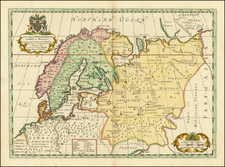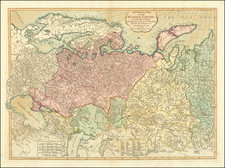Rare two-sheet map of Russia published in London first by John Senex in 1711 and subsequently (as in this example) by George Willdey in 1714.
Charles Price is credited in the title cartouche as well.
State
This second state lists the joint imprint of George Willdey and Timothy Brandreth.
Rarity
The map is very rare, appearing in select early-18th-century English composite atlases.
Not to be confused with the 1712 Senex Russia nor the folio map of Russia by Senex.
John Senex (1678-1740) was one of the foremost mapmakers in England in the early eighteenth century. He was also a surveyor, globemaker, and geographer. As a young man, he was apprenticed to Robert Clavell, a bookseller. He worked with several mapmakers over the course of his career, including Jeremiah Seller and Charles Price. In 1728, Senex was elected as a Fellow of the Royal Society, a rarity for mapmakers. The Fellowship reflects his career-long association as engraver to the Society and publisher of maps by Edmund Halley, among other luminaries. He is best known for his English Atlas (1714), which remained in print until the 1760s. After his death in 1740 his widow, Mary, carried on the business until 1755. Thereafter, his stock was acquired by William Herbert and Robert Sayer (maps) and James Ferguson (globes).
George Willdey was an optical instrument maker. He also sold globes, maps, and toys at his shop in Ludgate Street. Born in Staffordshire, Willdey moved to London after the death of his father, where he was bound as an apprentice to John Yarwell, an optician. He was made free of the Spectaclemakers’ Company in 1702, when he began work as a journeyman.
A few years later, Willdey started in business with Timothy Brandreth, working under the sign of the Archimedes and Globe. They competed for business with Yarwell and other opticians, advertising their wares in trade cards and periodical advertisements.
Willdey and his wife, Judith, had five children, three of which survived to adulthood. Judith was a Huguenot, which allowed Willdey to create a wider network of artisans and craftsman. He expanded his stock to toys and household decorations, in addition to instruments. From 1709 he also sold printed goods, including maps and globes, which he sold in partnership with John Senex. Willdey purchased the copper plates for many maps, such as Christopher Saxton’s atlas of England and Wales.
We note the following addresses:
- From 1707 to 1713 he operated "At the Archemedes & Globe, Ludgate Street." sometimes described as "Archimedes and Globe next the Dog Tavern nearer Ludgate."
- In 1712 in partnership with Timothy Brandreth also advertised at Archimedes and Globe over against the Royal Exchange in Cornhill.
- In 1715 his location was described as "At the Great Toy and Print Shop, the corner of Ludgate Street, next to St. Paul's"
- 1718 to 1737 as "At the Great Toy, Spectacle, China-Ware, and Print Shop, the Corner of Ludgate Street near St. Pauls London."
In 1717, Willdey split with Brandreth and expanded his stock further to include coffee and tea, snuff, medicine, china, and cutlery. He sold these wares from his shop at Ludgate and St. Paul’s Churchyard. He aggressively advertised his business in hundreds of newspaper advertisements; he also adopted many advertising gimmicks, such as erecting a giant burning glass on the roof of his store. Willdey was a leader in the Spectaclemakers’ Company. His wife frequently helped with the business and eight of his fifteen apprentices were women, which was very unusual for either the instrument and toy trades at the time.
Willdey died in 1737, although he had been in declining health for years and had tried to pass the business to his son, Thomas. He was remembered in The Old Whig, or, the Consistent Protestant as the “most noted Toyman in Europe.” After his death, the shop was run by Judith along with a former apprentice, Susanna Passavant. Thomas, it seems, was not suited to business.
Willdey’s daughter, Jane Frances, married a Peter Fenoulhet, clerk of the entries in the Excise Office. Fenoulhet sued on behalf of their son over the mismanagement of the family business by Thomas. These lawsuits produced eleven inventories of household and commercial stock between 1730 and 1737, the only extant shop accounts from the London instrument trade from this period.











![[European Russia] Гидрографическая Карта Европейской Россіи. Составлена Департаментом Проэентовъ И Смѣтъ Главнаго Управления Путей Сообщения и Публичныхъ Зданій | Hydrographical Chart of European Russia Compiled by the Project and Estimate Department of the Chief Direction of Ways of Communication & Public Buildings 1846.](https://storage.googleapis.com/raremaps/img/small/61005.jpg)
![(Ukraine, Poland, Russia, Georgia, Armenia) [Tabula II Asiae]](https://storage.googleapis.com/raremaps/img/small/102937.jpg)

![[Soviet Russian Ecology Propaganda Poster] Основы Водного Законодательства Союза ССР](https://storage.googleapis.com/raremaps/img/small/68343.jpg)

